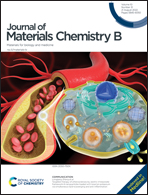Real-time, sensitive and simultaneous detection of GSH and Cys/Hcy by 8-substituted phenylselenium BODIPYs: a structure–activity relationship†
Abstract
Real-time and sensitive detection of biothiols is the key to biomedical research and clinical diagnosis. It is necessary to develop a highly sensitive and selective fluorescent probe for the detection of biothiols. In this paper, we have developed a series of meso-arylselenium BODIPY probes for the rapid and sensitive detection of biothiols and the dual-channel discrimination of GSH and Cys/Hcy. A structure–activity relationship was established from five p-substituted phenylselenium (R = NO2, F, H, OCH3 or N(CH2CH2)2O) BODIPYs. Compared with most reported fluorescent probes, such as meso-BODIPY sulfur ethers, these probes display much lower LODs (∼nM levels) and more rapid responses, which are ascribed to the higher fluorescence efficiencies of the sensing products (Φf = 0.48 for GSH, 0.18 for Cys and 0.14 for Hcy) and the introduction of arylselenium, which is more active than arylthiol. Among them, the best sensing performance is that of probe 2a (R = NO2); therefore, a structure–activity relationship of these fluorescent probes was also obtained. The excellent sensing performance was further revealed in the detection of GSH and Cys/Hcy in live cells.



 Please wait while we load your content...
Please wait while we load your content...